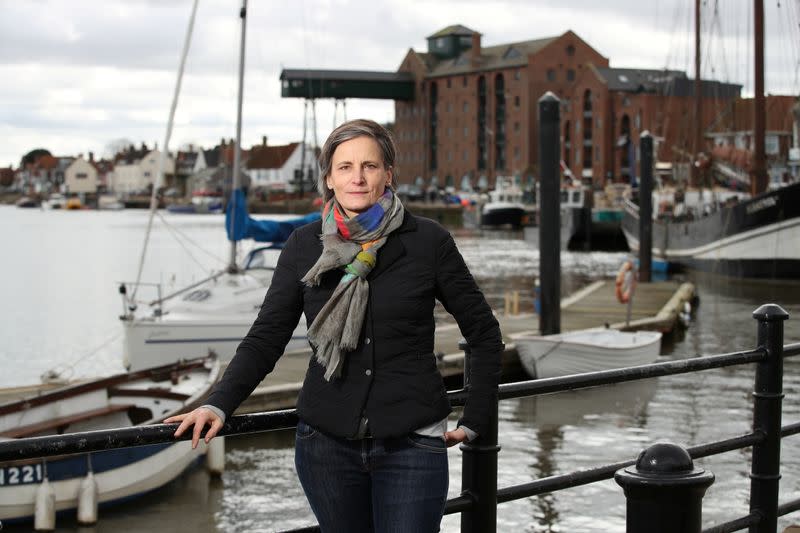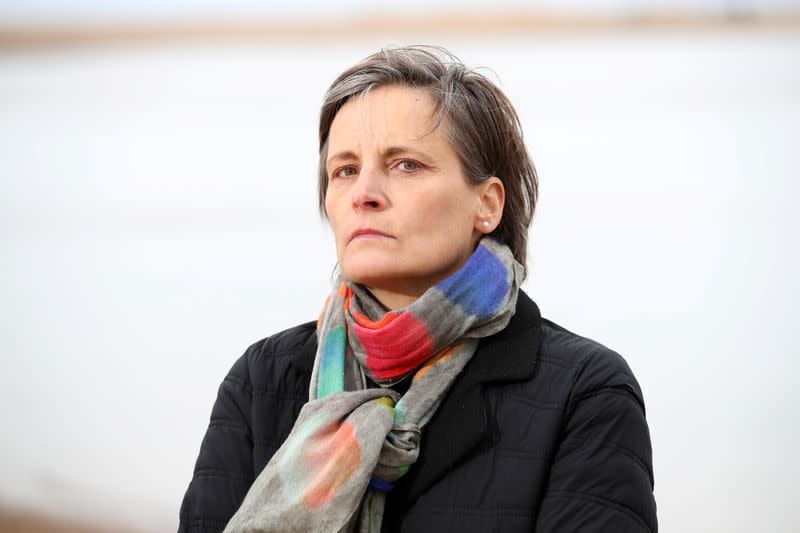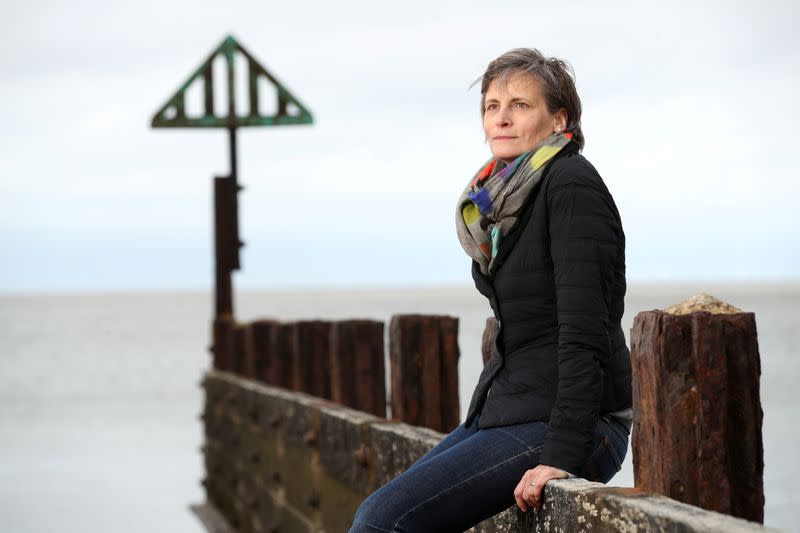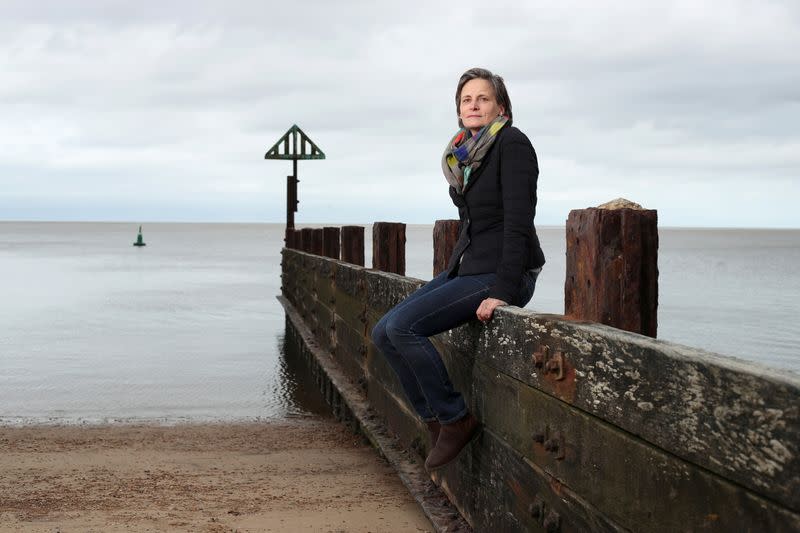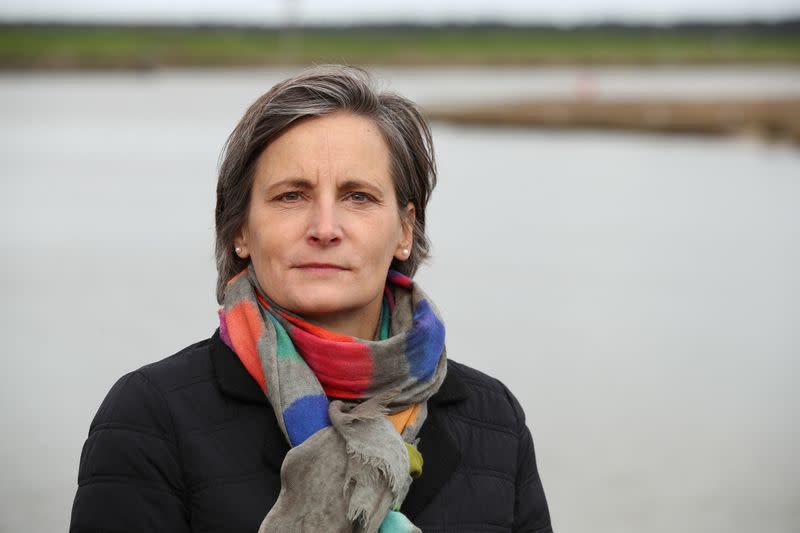Special Report-Men dominate climate science. She made it to the top - her way
By Maurice Tamman
NORWICH, England (Reuters) - Climate scientist Corinne Le Quéré sequestered herself in her home office last March. Outside, the streets were empty as Britain retreated from the coronavirus pandemic. The world had come to a halt. In the eerie stillness, she wanted to know: What did all this mean for emissions of carbon dioxide – and for human-driven climate change itself?
Colleagues were calling. Journalists were asking.
"I felt so embarrassed that I couldn't answer this question," Le Quéré recalled. "I mean, this is my area of research, and I know this is an obvious question, and I don't know the answer."
So, despite having a fever that she feared was caused by Covid-19 (she still isn't sure), Le Quéré mobilized a team of 13 scientists in six countries to try to get a snapshot of emissions during the pandemic, when the world burned less fossil fuel. In mid-March, she sent out the initial email, and 25 days later, the team had gathered and analyzed the data and submitted the paper – an almost head-spinning achievement in the deliberate world of science.
On May 17, the science journal Nature published their findings. On one day in April, carbon-dioxide emissions dropped by 17%, to levels last seen in 2006. That number made headlines around the world. Overall, however, carbon dioxide emissions were down just 7% for all of 2020, according to an update to the paper that she published in March 2021.
When it comes to the vast and relentless force of climate change, the effect of the pandemic pause might prove to be fleeting. The lockdown had highlighted the limitations of behavioral changes alone – staying home and not driving or traveling – on reducing the carbon-dioxide emissions that heat the planet.
"You do all this, this brutal change, and you only get a 17% decrease? For one day? You know, come on," she said.
For Le Quéré, the paper was another example of embracing the unexpected, something she's done all her life. If not for a missed deadline at the small university in Canada where she began her education, for instance, she might be a gym teacher today. Instead, she ranks near the top in a Reuters analysis of the most influential 1,000 scientists studying the climate, coming fourth among women and 53rd overall.
Of those scientists on the Reuters Hot List, fewer than one in seven are women. Le Quéré has long chafed at the sexism, subtle and not so, that she sees in the male-dominated field. Yet she has persisted. Today, few scientists know more about how carbon cycles through the atmosphere and oceans. In particular, she has documented how carbon dioxide is reaching what may be unsustainable levels for the future of the planet.
But it hasn't always been easy being surrounded by white men "of a certain age, of a certain type and very self-confident," as Le Quéré puts it.
Göran Hansson, secretary general of the Royal Swedish Academy of Sciences, said women remain extremely underrepresented in science, especially so among physicists and mathematicians.
For example, only about 10% of physics professors in Britain and 16% in the United States and Germany are women. Just seven women have won the Nobel Prize for chemistry, and four for physics. A century ago, the legendary Marie Curie won both – in chemistry for discovering the radioactive elements polonium and radium, and as co-winner in physics for her work on radioactivity.
"You need inspiring role models," Hansson said. "They are very helpful for young people when they decide which area to enter. And you can't underestimate the importance of Marie Curie in that way."
Le Quéré, 54, offers an update on the Curie model. Having achieved prominence in science, she's applying her research to the field of policymaking as an adviser to leaders of two European powers.
Quebec-born, she serves as the chair of France's High Council on Climate, which is charged with monitoring the country's efforts to reduce emissions and offering suggestions on how to move France away from fossil fuels. She also serves on the UK's Climate Change Committee, which produced a report that led to the British Parliament adopting a plan to reduce the country's carbon emissions to net zero by 2050.
Still, she's growing frustrated.
"For three or four years, I have worked with policymakers, and I just don't know how to make them realize they have to act," Le Quéré said. "I just don't know how to say things, what language to use. You know, what do I need to do?"
At some point, she said, governments will be faced with such dire consequences of climate disruption, they'll have to do something.
"Maybe it's like Covid. You know, it happened very quickly. And at some point, it was obvious that you had to put the measures in place very quickly," she said. "And I think with climate change, it's possibly going to be the same – it will become obvious."
A MISSED DEADLINE, A WHOLE NEW WORLD
Le Quéré's work has taken her all over the world. Today, she's a British citizen and carries Canadian and French passports. Coming out of high school in 1984, however, she was adrift. She enrolled in a general studies program at a small university near home in Gatineau, across the river from Ottawa, in the French-speaking province of Quebec.
Her early academic career was most notable for its lack of focus. As the end of her second year approached, she didn't know what to pursue.
"I rang up the sports department because I did a lot of sports in my childhood. I thought, 'OK, I'll be a sports teacher.'
"But they said, 'The [application] deadline was yesterday. Come back next year.'"
Not wanting to wait, on a whim she phoned the physics department at the University of Montreal. Physics was her favorite subject in high school.
"They said: 'Yeah, you're welcome here. We take everybody.'"
And that began her scientific journey. Her life's vocation came to her in the latter half of the 1990s at Princeton University, where she worked as a research assistant while raising her young daughter with her first husband. She threw herself into the study of the carbon cycle – the physical and biological processes by which carbon dioxide is captured and stored in the sea and on land, and sometimes released into the atmosphere.
Jorge Sarmiento, emeritus professor of geoscience and geological engineering, was her boss at Princeton. When she joined him, Le Quéré was an oceanographer. She didn't yet have the programming knowledge needed to conduct computer modeling, one of the prime tools climatologists use to estimate how changes in emissions of carbon dioxide and other greenhouse gases will affect everything from temperatures to rainfall. This was a major skills gap, because others working under Sarmiento were trying to create a model to see how the oceans fit into the carbon cycle.
His teams wanted to find a way to calculate how much carbon dioxide the oceans could absorb in coming years. It was an important question: Without knowing that, it's impossible to precisely predict how much carbon dioxide would be in the atmosphere.
But they were stuck. Le Quéré showed a knack for unraveling flawed programming and logic, and helped crack the code. Versions of those models remain in use today.
"She never took anything for granted," Sarmiento said, "and she always had to test other people's ideas out."
Le Quéré and her family left Princeton for Paris in 1996 so she could study for her Ph.D. In 1997, she gave a presentation in Cairns, Australia, on the physics of the carbon cycle to a gathering of scientists studying carbon dioxide in the atmosphere in China.
Ecosystem scientist Colin Prentice was there. Shortly before the event, he had been put in charge of authoring a chapter on the carbon cycle for the influential Intergovernmental Panel on Climate Change, which would be published as part of the panel's Third Assessment Report in 2001. It was the first time the body had dedicated a chapter to the topic – "quite a milestone," Prentice recalled.
Prentice, who ranks 158th on the Reuters Hot List, knew plenty about how carbon dioxide was absorbed by plants and stored in the soil. But he knew little about how carbon dioxide interacted with the oceans. Her presentation impressed him.
"And I thought I wanted this person on my team," he said. "It was a little bit awkward at the time because she didn't even have a Ph.D.," a degree she would acquire in 1999 from what's now known as Sorbonne University.
"That caused a little bit of consternation in some circles. But never mind, it was perfectly clear that she was the person you wanted, and she did an absolutely fantastic job."
Le Quéré cast a knowing look up toward the ceiling when reminiscing about being recruited by Prentice. She said she suspects the combination of her specialty in marine science and the lack of female scientists may have worked in her favor.
"I was a young woman when I did that good talk in a room full of men," she recalled. "I suspect that Colin had his team assembled and he had 10 men and he was looking for a woman. And he had very few oceanographers.
"Colin will say that, obviously, I could do the job and everything, but I think the reality is probably he was actually looking for women, and he was very lucky to find me."
Prentice says her gender wasn't part of his thinking then. "I don't have terribly much respect for formal qualifications," he said. "And in fact, I know a lot of women who come into science through somewhat unconventional careers. I mean, I knew it wasn't true that Corinne was underqualified in any meaningful sense. She just didn't actually have a piece of paper."
A SINGLE MOTHER AND A FEMALE SCIENTIST
After Le Quéré finished her Ph.D., Prentice persuaded her to join him at Germany's Max Planck Institute for Biogeochemistry. At that time, he did consider her gender, though it wasn't central to the decision to hire her.
"I don't think that the gender balance was mainly in my sights then, although it is, of course, a big issue," he said. "I was thinking about finding the right person. We had talked to a bunch of blokes, actually, over the previous year, and decided none of them were up to scratch."
In 2004, however, Le Quéré found herself facing an uncertain future, and not for the first time. Her work was going well, but her first marriage had fallen apart during the four years she worked in Germany.
She moved to Norwich in England and took a job at Britain's University of East Anglia. There, she faced a new challenge: single parenting.
Her daughter, Marianne, now 25, is studying the digital news media business for her Ph.D. at Cornell University in New York State. She says she got her lessons on sexism directly from her mother.
"I've seen her have a lot of private struggle," she said. "I've seen her come home from conferences and be like, 'This person was a pig.' I've seen her come home and cry."
Early in her career, Le Quéré said, she attended a meeting of the IPCC in Ispra, Italy. During the opening session, the chairwoman asked each of the chapter authors – all white men, Le Quéré recalls – to show one slide that encapsulated their findings.
One author showed a slide that suggested that as the planet warms, women will wear skimpier bathing suits, and joked that the picture proved climate change was real.
"He showed the picture, and everybody laughed. And that made me even more angry," she said. "I just waited and at the end, raised my hand, and then I said that I thought that your image was totally inappropriate in this setting."
Le Quéré said there were about 300 men in the room and only a smattering of women. Not a single person in the room rose to support her.
"I felt really angry, really, really angry with it. But at the same time, very embarrassed."
When the session broke, however, a white, middle-aged American man approached her.
"And he came to me and he said, 'Well, thank you for what you just said.'"
He was followed by a few more people, all men.
"They all said the same thing. Thank you. And I was kind of super surprised. I almost burst into tears. I probably was crying."
A 100,000-YEAR-OLD CHUNK OF ICE
The house where Le Quéré lived with her daughter is a 10-minute walk along hedgerow-lined Norwich streets from where she now lives with her second husband, Paulo. They met about 14 years ago at a salsa party. The way she remembers it, he was the best dancer in the room. She was the worst.
On a sunny autumn day before the pandemic, she sipped a glass of red wine in the lobby of the University of East Anglia building where she works as a research professor of climate change science.
She expectantly tapped on the glass, waiting to be called into a nearby theater for the next event in a local crime-writing festival called "Noirwich." She was part of a panel discussing "Crimes Against Nature." She looked down at her blue, closed-toe pumps, lifting her left foot to show them off.
Le Quéré says there's an understood dress code that most women follow when meeting French President Emmanuel Macron: "Blue suits or dresses, smart shoes, some sort of jewelry or scarf and/or earrings." She met Macron as chair of the country's High Council on Climate, which delivers reports and suggestions to the government on climate change.
"These are my Macron shoes," she said, reminiscing about the first meeting of the council, which the president established in 2018. They all gathered in a gilded room, and as the council chair, she was seated across the table from Macron. On his side were the prime minister and seven government ministers. On hers were fellow members of the council – climate scientists, economists, agronomists and energy transition experts.
She gave a brief speech. "I speak with a Quebec accent, and they all grin. I thank them for installing this new committee." And she joked about the "debates" that would certainly follow. That got a laugh, and she realized, "OK, I think I can do this."
Several years earlier, in 2010, Le Quéré and a colleague went to London to discuss the fate of the planet with David Cameron, then Britain's incoming prime minister.
They brought along a prop: a 100,000-year-old chunk of Antarctic ice.
They used it to show Cameron how air bubbles trapped in the ice could be used to measure the amount of carbon dioxide in the atmosphere when the water froze thousands of years ago.
After the meeting, Le Quéré grabbed the container of ice, hoping it wouldn't melt during the two-hour train ride home from London. She had an idea.
When she got home, she saw her family waiting in the living room for what she had told them was a "priceless" surprise. She opened the thermos; the ancient ice crackled and popped like Rice Krispies.
She paused dramatically. Then she broke the ice into cubes and mixed gin and tonics for her and her husband and iced orange juices for her daughter and stepson and stepdaughter.
"I FEEL SO POWERLESS"
Several years back, Le Quéré bought a cottage in a Norfolk village called Wells-next-the-Sea as a getaway. At low tide there, hints of the rotting smell of the harbor – part of the carbon cycle – sometimes fill the nose.
"This is where I come to write," Le Quéré said, sitting at a table in the cottage's garden.
She sipped on a cup of tea that her husband had brought to her. The sun was well into its afternoon descent to the west. The forecasters were right, it had been a beautiful day.
Which brought her to why she has some sympathy with those who have doubts about climate change.
Consider the five-day weather forecast. It's a mathematical model that digests a mountain of atmospheric data, seasonal variables, as well as local geography and topography, and returns the probability of sunshine, cloud cover, snow or rain, and the day's likely high and low temperatures.
While forecasts may seem simple, she said, they are remarkably complex calculations. And they are usually pretty accurate, notwithstanding the old joke about weather forecasters: I wish I could be wrong most of the time and keep my job.
Now consider a climate model. It makes similar predictions, not for the coming days, but for the coming years and decades.
So it's natural for a lay person to ask, if the weather forecast sometimes botches a blizzard call two days out, how can a climate model predict the planet's average temperature in 2050?
They are, in fact, very different. Instead of trying to account for the daily shifts in the atmosphere, climate models focus on what's known as energy balance, over periods of years. How much sunlight hits the planet. How much energy the planet absorbs or reflects. How the gases and moisture in the atmosphere react to that energy by absorbing or reflecting it back into space. And how the ratio of those gases – particularly carbon dioxide – changes over time by being added or removed from the atmosphere.
Actually, Le Quéré noted, getting a long-term model right may be easier than calling next week's cold snap. "It's just energy balance, and that's simpler than weather forecast, which is chaos, essentially organized chaos," Le Quéré said, her right hand shading her eyes from the afternoon sun.
Climate models have proven strikingly accurate, including the most famous of all, climatologist James Hansen's 1988 prediction that the average global temperature may rise 1 degree Celsius by 2019, which came to pass. But many people scoff, assuming that because the weather forecaster can miss the mark, models of the Earth's future climate can't possibly be right.
"I packed to come here for two days, and I packed very lightly because I know it's not going to rain. But sometimes weather forecasters make mistakes, and people remember those mistakes, especially if it affects them."
HOPE FOR THE FUTURE
A few years back, Le Quéré did a TED talk titled "Inside the Mind of a Climate Change Scientist." In it, she admitted that she doesn't bother trying to convince everyone that climate change is real anymore.
It's not that she doesn't want more of the public to understand her work; she does. It's that engaging the public often invites a vitriolic response from those who say climate change is a hoax or overblown.
"I will not confront you. I will not make you feel guilty," she said during the talk in the English city of Warwick. "But I will not stay still and do nothing about climate change."
She added: "I have a mountain of data on my shoulders, but I feel so powerless. I will not save anybody. I rely completely on you."
Last spring, sitting in her home office three months into the British pandemic lockdown, nothing had changed. "The fact is that many people don't believe in climate change. But many do. That's enough for me."
What she hopes is that gradually, with more science, people will come to understand what she knows.
"I do the work that I have to do, and eventually it will fall into place," she said. "I guess maybe I'm hopeful because I think eventually it will fall into place."
That doesn't mean she isn't worried about the future. "Often I'm scared," she said. "When I stop and think about the fundamentals, I can be very sad and very discouraged."
Last summer, Le Quéré and the members of her French climate council thought they had persuaded the government to invest in green infrastructure as part of their Covid-19 economic-stimulus package, such as research into clean hydrogen production and subsidies for insulating homes. When the announcement was made, however, the government said it was going to invest in a "clean airplane."
There's no such thing as a "clean" plane that runs on carbon-based fuels, she said, still fuming. Any such aircraft, even one using biofuels, will emit carbon dioxide. "You can make it more efficient," she said. "But that's not a clean plane, and it will never take you to that zero emission."
That setback is why Le Quéré took so much pleasure from her pandemic-related emissions research: It was an opportunity to focus attention on climate change, and perhaps prod governments into action.
Yes, the carbon dioxide drop was just a blip. Still, she said, the people who saw reports about the research were engaged in something that connected us all – the realization that we need to find ways to reduce emissions beyond simply buying an electric car or not traveling.
"This curiosity has led to sort of a mental connection between the pandemic and the pollution and environment in the mind of a lot of people," she said. "This moment, if we can offer something scientific that people want to know, then we will have for a day a voice that could have a big influence on the future of the planet."
(Reporting by Maurice Tamman; editing by Kari Howard)

 Yahoo Finance
Yahoo Finance 